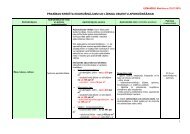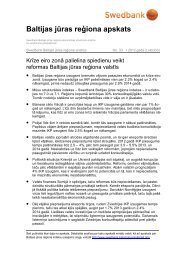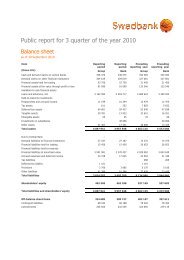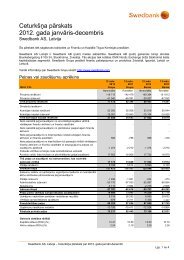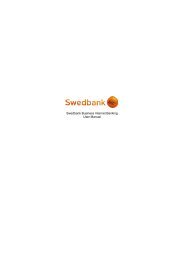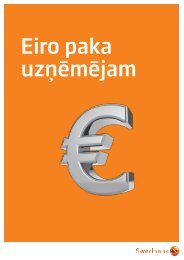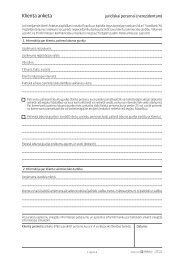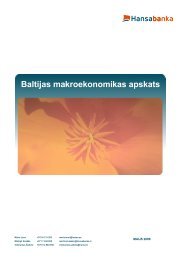Usage of logotype - Swedbank
Usage of logotype - Swedbank
Usage of logotype - Swedbank
- No tags were found...
Create successful ePaper yourself
Turn your PDF publications into a flip-book with our unique Google optimized e-Paper software.
Visual Foundation <strong>of</strong> <strong>Swedbank</strong>Logotype use<strong>logotype</strong><strong>logotype</strong> versions<strong>logotype</strong> size<strong>logotype</strong> background and placement<strong>logotype</strong>/<strong>Swedbank</strong> as sender<strong>logotype</strong>/co-brand as sender<strong>logotype</strong>/equal senders
Our <strong>logotype</strong> consists <strong>of</strong> a word mark and a symbol. The word mark and symbol may not beseparated or modified in any way. The <strong>logotype</strong> shall always be handled as an integrated unit.The <strong>logotype</strong> must not...…be stretched out……be pushed together…
Our <strong>logotype</strong> should primarily be used in colour. The greyscale version is only used when blackand white print is required. Positive and negative versions <strong>of</strong> the <strong>logotype</strong> do exist, but shouldonly be used in exceptional circumstances and are available upon request only.Our <strong>logotype</strong> should primarily be used in colour. The greyscale version is only used when blackand white print is required. Positive and negative versions <strong>of</strong> the <strong>logotype</strong> do exist, but shouldonly be used in exceptional circumstances and are available upon request only.
Logotype sizeMinimum sizeThe <strong>logotype</strong> should not be smaller than 25 mm. On our websites, the logo must not be smallerthan 150 pixels (not relevant for banners etc.)Standard sizesThe <strong>logotype</strong> size has been set for commonly used formats. You can use these standard sizes asa frame <strong>of</strong> reference when designing similar units.
Logotype free zoneGeneral minimum free zoneThe free zone defines the minimum space around the <strong>logotype</strong>. The basis for calculating the freezone is the “e” <strong>of</strong> the <strong>logotype</strong> word mark. Please note that the free zone may be larger.Logotype free zone with sphereWhen placing the <strong>logotype</strong> within the sphere in combination with the orange gradient colour, a setfree zone should be used. This free zone should always be applied (not made larger or smaller).For more information regarding using the sphere, see “Background and placement”.Download sphere
BackgroundsOur <strong>logotype</strong> should be placed on either a black or a white background.The <strong>logotype</strong> may also be placed on images – do make sure that the background is very light ordark (preferably white) and calm.When we place the <strong>logotype</strong> on orange gradient, a white or black sphere is used. To simplify, wehave created standard spheres ready for download. Please click here for download.
Placement <strong>of</strong> the <strong>logotype</strong>. The <strong>logotype</strong> should as a general rule always be placed horizontally inthe top right-hand corner. When required, however, the <strong>logotype</strong> may be placed in the left-handcorner (e.g. envelopes, letterheads etc.).When we strive for maximum <strong>logotype</strong> impact we can place the <strong>logotype</strong> centred, vertically orhorizontally (e.g. roll-ups, arena sponsorship, packshot on TV etc.). We never centre the <strong>logotype</strong>in standard printed communication.
When <strong>Swedbank</strong> is defined as the sender <strong>of</strong> communication our identity and design are applied,both in terms <strong>of</strong> content and appearance. In practice this means that we design the co-brandingactivity according to <strong>Swedbank</strong>’s design guidelines, with our own <strong>logotype</strong> in the sender positionand the co-brand in a subordinate partner position. Always make sure to use the correct version<strong>of</strong> our partner’s <strong>logotype</strong> for different applications and manage it with respect in terms <strong>of</strong>placement, background and colour.Logotype placementThe <strong>Swedbank</strong> <strong>logotype</strong> is always placed in the sender position according to our overall designguidelines. The co-brand <strong>logotype</strong> is placed separated from our <strong>logotype</strong>, preferably in thediagonally opposite corner. The <strong>logotype</strong>s must never be connected or placed as a parallelsender.
The area for placing co-brand <strong>logotype</strong>s must always be neutral and clear. We don’t place cobrandsin our own design elements, for example the bow or pattern. Our design elements areexclusive to our own brand. The aim is to signal co-operation without mixing designs andidentities.For guidelines regarding placement <strong>of</strong> co-brand <strong>logotype</strong>s against different backgrounds, pleasesee “Co-brand background”.Co-branding bylineTo clarify the co-branding relationship we present the co-brand with a set byline “In collaborationwith” (or in local languages). Alternative texts may be used if they provide a better explanation <strong>of</strong>the specific relationship, but the text must always be concise and clear.The co-branding by-line is usually used in combination with the co-brand’s <strong>logotype</strong>. The co-brandmay however also be presented in text when this is more suitable. The name <strong>of</strong> the co-brand inthese cases is typed in direct connection to the co-branding byline or corresponding text.
The text should preferably be placed above the co-brand <strong>logotype</strong>, with respect for the <strong>logotype</strong>’sfree zone. The text may also be placed to the left <strong>of</strong> the co-brand <strong>logotype</strong>, if the shape and size<strong>of</strong> the unit demands it. If no free zone is defined we use the principle outlined here.
Co-brand colourThe co-brand <strong>logotype</strong> may appear in positive colour, black or white. Which colour to usedepends on the background and the agreement with our partner. For more information, pleasesee the section “Co-brand background”.Co-brand backgroundAs a general rule, co-brands are placed on a black or white background.When we use orange or an orange tint as the main colour on a unit, the co-brand is placed in awhite or black border at the bottom <strong>of</strong> the unit. Guidelines regarding design <strong>of</strong> the border can befound in the section “Co-branding byline”.The co-brand <strong>logotype</strong> may be placed on images, if the image area is calm and almost completelywhite or black.
Logotype sizeThe <strong>logotype</strong> size may not be exactly defined in advance, as it depends on the shape <strong>of</strong> the<strong>logotype</strong> and the applications in question, but the impression should be that the co-brand issomewhat smaller or less prominent, approximately 70% the size <strong>of</strong> <strong>Swedbank</strong>’s <strong>logotype</strong>.Logotype size – perceived
More than one co-brandSometimes we collaborate with more than one partner. When we do, we treat all co-brands asequals and manage them uniformly in terms <strong>of</strong> colour, size and placement. The co-brands shouldpreferably be placed horizontally and as a group as shown in the examples below.
Application examples
When the co-brand is the sender <strong>of</strong> communication the co-brand’s identity and design are applied.The co-brand <strong>logotype</strong> takes the sender position, and the <strong>Swedbank</strong> <strong>logotype</strong> a subordinatepartner position.In these situations we <strong>of</strong>ten have limited control over content and appearance. However, we shallalways play an active role to ensure that our brand and <strong>logotype</strong> are managed correctly, and thatthe relationship between the co-operating brands can be perceived clearly in all communication.The only elements that may be used in a third party context are the <strong>Swedbank</strong> name and<strong>logotype</strong> (with a co-branding byline in our typeface). No other elements, such as imagery, coloursand patterns, may be used.Co-branding byline and artworkTo clarify the relationship between brands we should use our <strong>logotype</strong> in combination with a cobrandingbyline. The preferred co-branding byline is “In collaboration with” (or in local languages).The text is typed in <strong>Swedbank</strong>’s typeface and placed according to the following principle:To simplify and maintain correct handling by our partners, we use specific co-branding artwork.The artwork includes the co-branding byline. Be sure to provide our partners with the correct<strong>logotype</strong>. The co-branding <strong>logotype</strong> can be downloaded from Brand Manager.If the partner, and main brand, does not allow us to use our own typography in the co-brandingbyline they may use a neutral typeface, such as Arial or Helvetica. In these cases, the minimumfree zone and placement <strong>of</strong> the co-branding byline should be set according to the principlesbelow.
Logotype placement and free zoneThe <strong>Swedbank</strong> <strong>logotype</strong> is placed separate from the main sender, in separate corners or similar.The <strong>logotype</strong>s must never be connected.When placing our co-branding <strong>logotype</strong>, the minimum free zone must always be respected.The minimum free zone for the co-branding <strong>logotype</strong> is set according to the principled outlinedhere.
When <strong>Swedbank</strong> appears as co-sender <strong>of</strong> a joint activity with equal senders, the context shouldbe as neutral as possible and no one party should be predominant. Names, identities or <strong>logotype</strong>sshould never be mixed. Both parties’ identities and designs should be maintained and keptseparate.Avoid communicating equal partnerships with brands that lack sufficient strength and recognition.Also avoid using <strong>Swedbank</strong> as a co-sender if the context is dominated by another brand.If possible, strive for a sender role. In many cases <strong>Swedbank</strong> will be the stronger brand. It may bemore attractive for both brands if <strong>Swedbank</strong> takes the driving role in communication. If <strong>Swedbank</strong>does take the sender role, follow the guidelines in the section “<strong>Swedbank</strong> as sender”.Neutral designA neutral design is a design that is not based on any one <strong>of</strong> the brands co-operating. Colours,design elements, typography and images should be neutral in relation to all brands. Preferablyuse a simple design with colours that harmonise with the <strong>logotype</strong>s, and descriptive rather thanpr<strong>of</strong>iling images. It is especially important to keep it simple if the material is produced by nonpr<strong>of</strong>essionaldesigners, or is printed on <strong>of</strong>fice printers. When we work with pr<strong>of</strong>essional designers,it is possible to create more expressive colourful design concepts that are neutral.Placement, <strong>logotype</strong> size and colourNo brand should appear as more prominent, important or visible than the other. The placementand size <strong>of</strong> the <strong>logotype</strong>s should be equal. The same goes for colour. All <strong>logotype</strong>s arereproduced in full colour, or in black and white. Always bear in mind our <strong>logotype</strong>’s free zone anddo not place other <strong>logotype</strong>s, objects or text within its boundaries.Co-branding bylineIf appropriate, it is possible to use a co-branding byline to communicate and clarify the jointactivity: “<strong>Swedbank</strong> and Co-brand in co-operation” (or in local languages). It is optional to use theco-branding byline in equal partnerships



